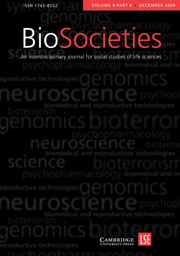Article contents
‘Breast Cancer on Long Island’: The Emergence of a New Object Through Mapping Practices
Published online by Cambridge University Press: 01 June 2007
Abstract
In late 1980s and early 1990s ‘breast cancer on Long Island’ emerged as a distinct object characterized by higher than average incidence rates that some speculated could be explained by environmental factors. The scientific community and its discourses have played an authoritative role in delimiting what is officially ‘known’ and ‘not known’ about this specific disease ontology. This article moves beyond an epistemological focus towards what Annemarie Mol calls a ‘praxiographical’ inquiry into the everyday practices that produce complex disease objects. We consider how multiple and multi-sited practices of mapping breast cancer on Long Island—by activists, scientists and the state—contributed to the emergence of this new object, and to its multiple and shifting enactments over time. We explore the tensions and power relations between the ‘lay’ public and scientific ‘experts’, and how these influenced mapping practices and produced ‘breast cancer on Long Island’ as a complex and ongoing politico-scientific event.
Information
- Type
- Articles
- Information
- Copyright
- Copyright © London School of Economics and Political Science 2007
References
- 1
- Cited by

